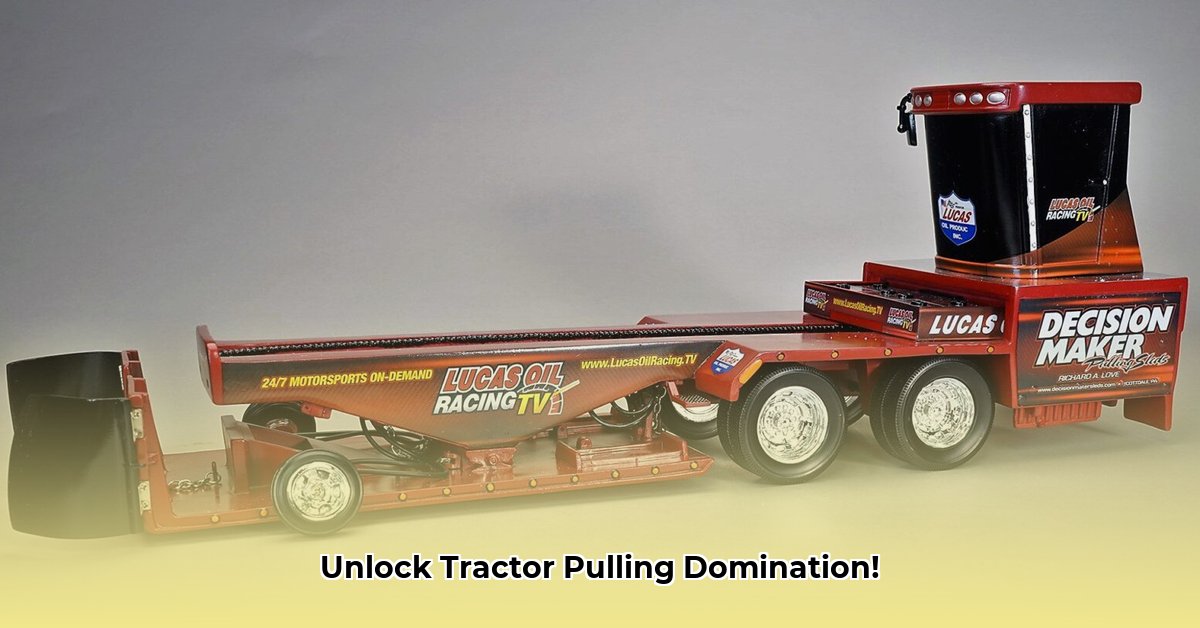
Understanding the Beast: Sled Mechanics
Tractor pulling isn't just about horsepower; it's a strategic interplay between engine power and sled design. Winning requires a deep understanding of these massive structures, designed to test even the most powerful tractors. These aren't simple sleds; they're meticulously engineered behemoths built to withstand incredible stress. The fundamental design involves a heavy steel frame onto which massive weights are secured. These weights create resistance, forcing the tractor to exert maximum power. For more information on tractor pulling events, check out this helpful resource.
But it's not just about weight; weight distribution is crucial. A poorly balanced sled offers less resistance in certain areas, giving the tractor an unfair advantage. Experienced builders understand this principle; they strategically position weights to create uneven resistance, challenging the tractor's grip and wheel turning. This uneven resistance tests the tractor's power and the driver's skill.
The sled's surface also matters. Different materials and designs impact traction. Some incorporate hooks or teeth to further challenge the tractor's grip, dramatically influencing the outcome of a pull. And don't forget the ground; soil type, moisture, and track condition all affect the sled's resistance. Adapting to these conditions is key to success. How much does ground type influence sled performance in tractor pulling competitions? Studies show significant variations depending on soil composition and moisture content.
Types of Tractor Pulling Sleds: A Variety of Challenges
Tractor pulling sleds come in various designs for different power classes and competition types. Competition sleds are more sophisticated, often including adjustable weight components for fine-tuning resistance.
Some sleds maximize power transfer from tractor to ground, using specialized surfaces or mechanisms to amplify resistance. Others focus on creating an unpredictable pull, adding a strategic skill component beyond raw horsepower. What percentage of competitive tractor pulling events utilize modified weight sleds? While precise figures are unavailable, anecdotal evidence suggests a significant portion.
| Sled Type | Description | Typical Characteristics |
|---|---|---|
| Standard Weight Sled | The most common type; utilizes strategically placed weights for consistent pull. | Heavy frame, adjustable weight blocks, relatively smooth surface |
| Modified Weight Sled | Modified versions with additional features to enhance resistance or unpredictability. | Added hooks, teeth, or other mechanisms; potentially uneven weight |
| Specialty Sleds | Unique designs created for specific competitions or power classes. | Highly customized based on contest rules and tractor capabilities |
Building Your Own Sled: A Step-by-Step Guide
Building a competition-ready sled is a major undertaking, demanding engineering, welding, and material science expertise. This simplified guide outlines the key steps:
Design and Planning: Begin with detailed blueprints and calculations, including size, weight, weight configuration, and material selection. Adhere to competition rules.
Material Acquisition: Source high-strength steel for the frame and appropriate weights (often scrap metal, but meeting safety standards).
Frame Fabrication: Weld the frame according to your plans. Robust construction is vital for safety and structural integrity.
Weight Integration: Securely attach weights based on the design. Safety and stability are paramount.
Surface Modification (optional): Attach hooks or teeth if your design specifies. Ensure secure fastening.
Testing and Refinement: Rigorously test the sled and make adjustments based on the results. Testing is crucial for identifying weaknesses and improving design.
The Pros and Cons of Building Your Own Sled
| Pros | Cons |
|---|---|
| Customization for optimal performance | High initial investment in materials and equipment |
| Potential cost savings (depending on materials) | Requires significant skill in engineering, welding, and fabrication |
| Greater understanding of sled mechanics | Time-consuming process; could take weeks or months to complete |
Winning Strategies: Beyond the Sled
A well-designed sled is essential, but victory depends on more than just the sled. Tractor horsepower, driver skill, and track conditions play crucial roles. Experienced pullers meticulously prepare, testing weight configurations, adjusting tire pressure, and practicing techniques. "Ongoing research is constantly refining our understanding of optimal sled design," explains Dr. Anya Sharma, Professor of Mechanical Engineering at Purdue University. She adds, "The dynamics of tractor pulling are complex, requiring a holistic approach encompassing tractor capabilities, driver skill, and environmental factors."
Key Takeaways:
- Weight distribution is crucial for creating effective sled resistance.
- Different sled types are designed for various competitions and power classes.
- Building a sled requires significant engineering and fabrication skills.